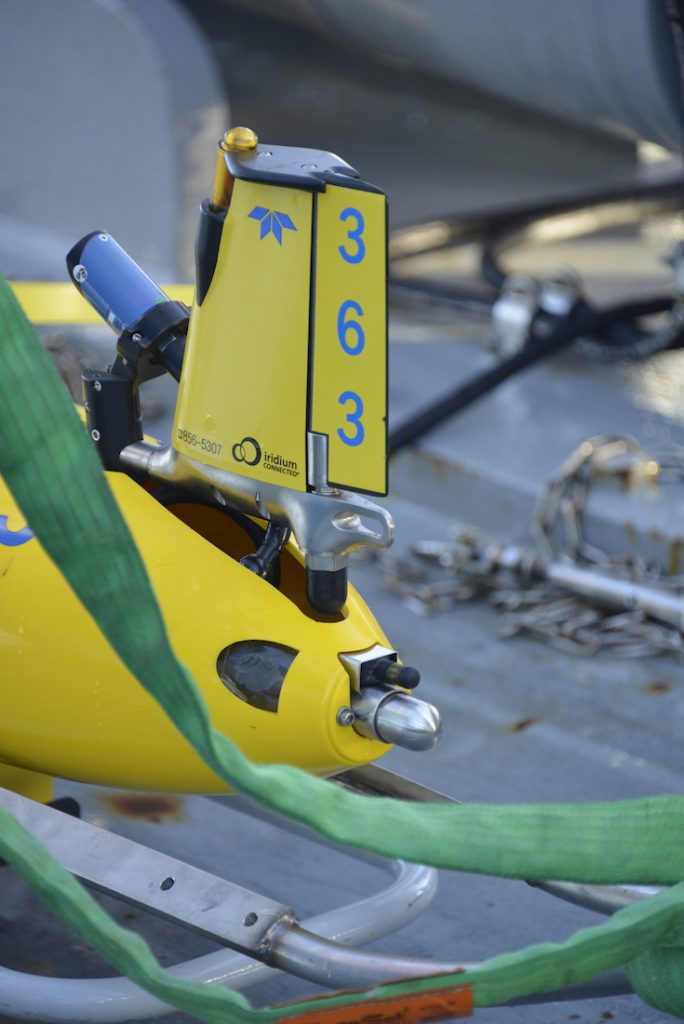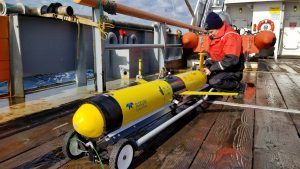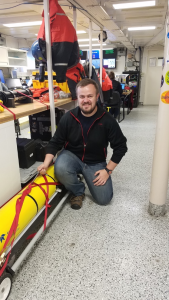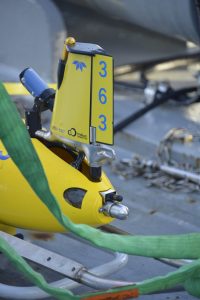
Glider Day at Pioneer 17

Technician Diana Wickman
Inclement weather has made us slightly adjust our schedule of what to put into the water each day. Today started off with a glider deployment.
Gliders are an integral part of the OOI and are operated at both the Coastal and Global Arrays. Gliders at the Coastal Arrays (Pioneer and Endurance) sample the water space between the moorings, gathering data such as dissolved oxygen, conductivity, temperature, and depth, water currents, fluorescence, dissolved organic matter and photosynthetically available radiation. Gliders at the Global Arrays (Irminger and Papa) come in two configurations, one is responsible for sampling the water column above the sub-surface Profiler Mooring, and the other is tasked with sampling the water between the sub-surface moorings and also retrieving subsets of the mooring data to be telemetered to shore. These sub-surface mooring data would not be available otherwise until the moorings were recovered, but the glider gives us access to the data in near real-time.
Diana Wickman and Collin Dobson are charged with keeping CGSN’s fleet of gliders operational, which is no small task. Today they deployed Glider 363, a glider normally deployed to one of the Global Arrays, for a sea trial to determine if repairs made to the glider’s steering apparatus were successful. Glider 363 had been deployed previously at OOI’s Global Station Papa site but had to be recovered early when it was discovered that the glider was not able to properly execute programmed steering commands. Without the steering capability working properly the glider was not as effective in gathering data from the sub-surface moorings and was also at risk of being unable to maintain station in the array.

Technician Collin Dobson
“This glider is considered one of our Global ‘data mules’ meaning it obtains data stored on sub-surface moorings via acoustic modem then telemeters that data to shore via the Iridium Satellite Network,” said Wickman, who has been working with gliders since 2014. She explained that they are sophisticated workhorses that collect data as they travel on a pre-programmed path through the water. When these Global Gliders surface, they transmit the data collected from both their own internal sensors and from the sub-surface moorings through the iridium satellite network, which are then transmitted to shore. The team had tested the glider previously in the lab and in shallow water, and this was considered the penultimate test before being cleared for official redeployment back to a Global Array. The gliders, especially those deployed at the Global sites, are rigorously tested to ensure they have the best chance of enduring a grueling 365-day mission at sea.

The Pioneer 17 team placed glider 363 in the water for a test run of its steering mechanism.
When asked what drove Dobson and Wickman to their work with gliders, each had a different reason, but it was clear that both are passionate about their work. When Wickman saw her first glider she was immediately drawn to it, “something about having a whole system on the bench in front of me that I can know inside and out from end to end really appeals to me,” said Wickman. Dobson’s interests in gliders began as an undergraduate. During his first week in a program at Rutgers, he found himself in a boat recovering a glider and the rest is history. He’s been taking apart and putting gliders back together ever since. “It simply makes sense to me, especially from a software standpoint,” he added.
Together, with their supervisor and OOI’s Coastal and Global Scale Nodes (CGSN) Operations Lead Peter Brickley, this team is keeping the CGSN glider fleet in tip top shape so they can continue to contribute important data to help us better understand what’s happening in the ocean.
Images and Text by Darlene Trew Crist©WHOI.
